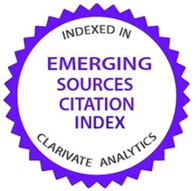Validación del concepto de eficacia colectiva. Un estudio en barrios latinoamericanos
DOI:
https://doi.org/10.21830/19006586.1298Palabras clave:
análisis factorial, barrios latinoamericanos, control social, eficacia colectiva, prevención del crimen, seguridad urbanaResumen
El concepto de eficacia colectiva vinculado a la investigación de delitos en barrios surgió en Estados Unidos en los años noventa y pronto fue reconocida como una teoría validada. Sin embargo, su aplicación en América Latina ha evidenciado inconsistencias. A partir de datos de Bogotá, Lima y Santiago, este artículo evalúa la estructura factorial del concepto y su aplicabilidad al estudio de delitos violentos en barrios latinoamericanos. Para ello se estimaron modelos factoriales, invarianza y comparación de medias. Los hallazgos revelan que la eficacia colectiva se compone de tres dimensiones (confianza, cohesión y control social informal), y para cada dimensión se observan medias diferenciadas según experiencia de victimización violenta y ciudad. Así, la composición multidimensional de la eficacia colectiva ofrece una perspectiva enriquecedora para profundizar en los desafíos de la prevención del delito en entornos criminológicos complejos del Sur global.
Descargas
Referencias bibliográficas
Alavi, M., Visentin, D. C., Thapa, D. K., Hunt, G. E., Watson, R., & Cleary, M. (2020). Chi‐square for model fit in confirmatory factor analysis. Journal of Advanced Nursing, 76(9), 2209-2211. https://doi.org/10.1111/jan.14399
Anckar, C. (2008). On the applicability of the most similar systems design and the most different systems design in comparative research. International Journal of Social Research Methodology, 11(5), 389-401. https://doi.org/10.1080/13645570701401552
Auyero, J., & Sobering, K. (2019). The ambivalent State. Police-criminal collusion at the urban margins. Oxford University Press.
Bandura, A. (1982). Self-efficacy mechanism in human agency. American Psychologist, 37(2), 122-147. https://doi.org/10.1037/0003-066X.37.2.122
Bandura, A. (1986). Social foundations of thought and action: A social cognitive theory. Prentice-Hall.
Bartholomew, D. J., Steele, F., Steele, F., & Moustaki, I. (2008). Analysis of multivariate social science data. Chapman and Hall; CRC. https://doi.org/10.1201/b15114
Borsboom, D., Mellenbergh, G. J., & van Heerden, J. (2003). The theoretical status of latent variables. Psychological Review, 110(2), 203-219. https://doi.org/10.1037/0033-295X.110.2.203
Briggs, N. E., & MacCallum, R. C. (2003). Recovery of weak common factors by maximum likelihood and ordinary least squares estimation. Multivariate Behavioral Research, 38(1), 25-56. https://doi.org/10.1207/S15327906MBR3801_2
Brown, T. (2015). Confirmatory factor analysis for applied research (2.ª ed.). The Guilford Press.
Browne, M. W., & Cudeck, R. (1992). Alternative ways of assessing model fit. Sociological Methods & Research, 21(2), 230-258. https://doi.org/10.1177/0049124192021002005
Browning, C., Feinberg, S., & Dietz, R. (2004). The paradox of social organization: Networks, collective efficacy, and violent crime in urban neighborhoods. Social Forces, 83(2), 503-534.
Bruinsma, G., Pauwels, L., Weerman, F., & Bernasco, W. (2013). Social disorganization, social capital, collective efficacy and the spatial distribution of crime and offenders: An empirical test of six neighbourhood models for a Dutch city. British Journal of Criminology, 53(5), 942-963.
Burchfield, K., & Silver, E. (2013). Collective efficacy and crime in Los Angeles neighborhoods: Implications for the latino paradox. Sociological Inquiry, 83(1), 154-176. https://doi.org/https://doi.org/10.1111/j.1475-682X.2012.00429.x
Bursik, R., & Grasmick, H. (1993). Neighborhoods and crime: the dimensions of effective community control. Lexington.
Casas, A., & Méndez, N. (2017). Capital social, lealtad y eficacia colectiva: una aproximación microsocial a la seguridad y la convivencia en las comunas de Medellín. En J. Giraldo (Ed.), Territorios y sociabilidades violentas San Juan, São Paulo, Cali y Medellín. Eafit.
Child, D. (2006). The essentials of factor analysis. Continuum.
Desmond Arias, E., & Barnes, N. (2017). Crime and plural orders in Rio de Janeiro, Brazil. Current Sociology, 65(3), 448-465. https://doi.org/10.1177/0011392116667165
Desmond Arias, E., & Goldstein, D. (2010). Violent pluralism: understanding the new democracies of Latin America. En E. Desmond Arias & D. Goldstein (Eds.), Violent democracies in Latin America (pp. 1-34). Duke University Press.
Frimpong, L. K., Oteng-Ababio, M., Owusu, G., & Wrigley-Asante, C. (2018). Collective efficacy and fear of crime in urban neighbourhoods in Ghana. Safer Communities, 17(3), 167-181. https://doi.org/10.1108/SC-06-2017-0024
Frühling, H., & Gallardo, R. (2012). Programas de seguridad dirigidos a barrios en la experiencia chilena reciente. Revista INVI, 74(27), 149-185.
Gerell, M., & Kronkvist, K. (2016). Violent crime, collective efficacy and city-centre effects in Malmö. British Journal of Criminology, 57(5), 1185-1207. https://doi.org/10.1093/bjc/azw074
Hardyns, W., Pauwels, L. J. R., & Khalfa, R. (2022). Structural neighbourhood characteristics, perceived collective efficacy and perceived disorder: A multilevel study on fear of crime. Monatsschrift fur Kriminologie und Strafrechtsreform, 105(3), 187-202. https://doi.org/10.1515/mks-2021-0155
Hipp, J. (2016). Collective efficacy: How is it conceptualized, how is it measured, and does it really matter for understanding perceived neighborhood crime and disorder? Journal of Criminal Justice, 46, 32-44. https://doi.org/10.1016/j.jcrimjus.2016.02.016
Hipp, J., & Wickes, R. (2017). Violence in urban neighborhoods: A longitudinal study of collective efficacy and violent crime. Journal of Quantitative Criminology, 33(4), 783-808. https://doi.org/10.1007/s10940-016-9311-z
Hipp, J., & Wo, J. C. (2015). Collective efficacy and crime. En International Encyclopedia of the Social & Behavioral Sciences (pp. 169-173). Elsevier. https://doi.org/10.1016/B978-0-08-097086-8.45045-2
Jiménez-García, W. G., Manzano-Chávez, L., & Mohor-Bellalta, A. (2021). Medición de la vulnerabilidad social: propuesta de un índice para el estudio de barrios vulnerables a la violencia en América Latina. Papers: Revista de Sociología, 106(3), 381-412. https://doi.org/https://doi.org/10.5565/rev/papers.2850
Kline, R. (2016). Principles and practice of structural equation modelling (4.ª ed.). The Guilford Press.
Kochel, T. (2013). Robustness of collective efficacy on crime in a developing nation: Association with crime reduction compared to police services. Journal of Crime and Justice, 36(3), 334-352. https://doi.org/10.1080/0735648X.2012.698102
Kornhauser, R. (1978). Social sources of delinquency: An appraisal of analytic models. University of Chicago Press.
Lindblad, M. R., Manturuk, K. R., & Quercia, R. G. (2013). Sense of community and informal social control among lower income households: The role of homeownership and collective efficacy in reducing subjective neighborhood crime and disorder. American Journal of Community Psychology, 51(1-2), 123-139. https://doi.org/10.1007/s10464-012-9507-9
Luneke, A. & Varela, F. (2020). Violencia y seguridad en los márgenes urbanos: la respuesta chilena en los vecindarios (2001-2019). Revista CS, 32, 43-75. https://tinyurl.com/jc75ehfu
MacCallum, R. C., Browne, M. W., & Sugawara, H. M. (1996). Power analysis and determination of sample size for covariance structure modeling. Psychological Methods, 1(2), 130-149. https://doi.org/10.1037/1082-989X.1.2.130
Manzano-Chávez, L. (2017). Experiences of violent and property victimization in Santiago neighbourhoods: Multilevel approaches to social disorganization theory and new ecological studies of crime [tesis doctoral, The University of Edinburgh, UK]. http://hdl.handle.net/1842/33247
Manzano-Chávez, L., Mohor, A., & Jiménez-García, W. G. (2020). Violent victimization in poor neighborhoods of Bogotá , Lima , and Santiago: Empirical test of the social disor ganization and the collective efficacy theories from the social disorganization theory to the collective efficacy. En X. Bada & L. Rivera-Sánchez (Eds.), The Oxford handbook of the sociology of Latin America (July, pp. 818-844). Oxford University Press. https://doi.org/mtsj
Mazerolle, L., Wickes, R., & McBroom, J. (2009). Community variations in violence: The role of social ties and collective efficacy in comparative context. Journal of Research in Crime and Delinquency, 47(1), 3-30.
Morenoff, J., Sampson, R., & Raudenbush, S. (2001). Neighborhood inequality, collective efficacy, and the spatial dynamics of urban violence. Criminology, 39(3), 517-558. https://doi.org/10.1111/j.1745-9125.2001.tb00932.x
Olavarría, M., Tocornal, X., Manzano, L., & Fruhling, H. (2008). Crimen y violencia urbana. Aportes de la ecología del delito al diseño de políticas públicas. Revista INVI, 23(64), 19-59. http://www.redalyc.org/articulo.oa?id=25806402
Olavarría-Gambi, M., & Allende-González, C. (2014). Crime in neighborhoods: Evidence from Santiago, Chile. Crime Prevention and Community Safety, 16(3), 205-226. https://doi.org/10.1057/cpcs.2014.7
Oteng-Ababio, M., Owusu, A. Y., Owusu, G., & Wrigley-Asante, C. (2017). Geographies of crime and collective efficacy in urban Ghana. Territory, Politics, Governance, 5(4), 459-477. https://doi.org/10.1080/21622671.2016.1159602
Quintero Cordero, S. P. (2020). Seguridad ciudadana y participación de las comunidades en América Latina. Revista Científica General José María Córdova, 18(29), 5-24. https://doi.org/10.21830/19006586.561
R Core Team. (2023). A language and environment for statistical computing. R Foundation for Statistical Computing. https://www.R-project.org/
Rhineberger-Dunn, G., & Carlson, S. (2009). Factor analyses of collective efficacy and police satisfaction. Journal of Crime and Justice, 32(1), 125-154.
Rhineberger-Dunn, G., & Carlson, S. (2011). An analysis of the mediating effects of social relations and controls on neighborhood crime victimization. Western Criminology Review, 12(1), 15-34. http://wcr.sonoma.edu/v12n1/Rhineberger-Dunn.pdf
Ruíz, J. (2010). Eficacia colectiva, cultura ciudadana y victimización: Un análisis exploratorio sobre sus relaciones con diversas medidas del miedo al crimen. Acta Colombiana de Psicología, 13(1), 103-114. http://www.redalyc.org/pdf/798/79815637009.pdf
Sampson, R. (2012). Great American city. Chicago and the enduring neighborhood effect. The University of Chicago Press.
Sampson, R. J., & Groves, B. (1989). Community structure and crime: Testing social-disorganization theory. American Journal of Sociology, 94(4), 774-802.
Sampson, R., Raudenbush, S., & Earls, F. (1997). Neighborhoods and violent crime: A multilevel study of collective efficacy. Science, 277(5328), 918-924. https://doi.org/10.1126/science.277.5328.918
Sampson, R., & Wikström, P.-O. (2008). The social order of violence in Chicago and Stockholm neighborhoods: A comparative inquiry. En S. Kalyvas, I. Shapiro, & T. Masoud (Eds.), Order, conflict, and violence (pp. 97-119). Cambridge University Press. https://doi.org/10.1017/CBO9780511755903.006
Shaw, C., & McKay, H. (1969). Juvenile delinquency and urban areas (2.ª ed). The University Chicago Press.
Silva, B. (2014). Social disorganization and crime. Searching for the determinants of crime at the community level. Latin American Research Review, 49(3), 218-230. https://doi.org/10.1353/lar.2014.0041
Sutherland, A., Brunton-Smith, I., & Jackson, J. (2013). Collective efficacy, deprivation and violence in London. British Journal of Criminology Advance Access, 53(6), 1050-1074. https://doi.org/10.1093/bjc/azt050
Triplett, R., Sun, I., & Gainey, R. (2005). Social Disorganization and the ability and willingness to enact control: A preliminary test. Western Criminology Review, 6(61), 89-103. https://tinyurl.com/4fkyfsux
Vilalta, C., & Muggah, R. (2016). What explains criminal violence in Mexico City? A test of two theories of crime. Stability: International Journal of Security & Development, 5(1). https://doi.org/10.5334/sta.433
Villarreal, A., & Silva, B. (2006). Social cohesion, criminal victimization and perceived risk of crime in brazilian neighborhoods. Social Forces, 84(3), 1725-1753. https://doi.org/https://doi.org/10.1353/sof.2006.0073
Warner, B. (2007). Directly intervene or call the authorities? A study of forms of neighborhood social control within a social disorganization framework. Criminology, 45(1), 99-129.
Watkins, M. (2018). Exploratory factor analysis: A guide to best practice. Journal of Black Psychology, 44(3), 219-246.
Wickes, R., Hipp, J., Sargeant, E., & Homel, R. (2013). Collective efficacy as a task specific process: Examining the relationship between social ties, neighborhood cohesion and the capacity to respond to violence, delinquency and civic problems. American Journal of Community Psychology, 52(1-2), 115-127. https://doi.org/10.1007/s10464-013-9582-6
Zahnow, R., Corcoran, J., Kimpton, A., & Wickes, R. (2022). Neighbourhood places, collective efficacy and crime: A longitudinal perspective. Urban Studies, 59(4), 789-809. https://doi.org/10.1177/00420980211008820
Zhang, L., Messner, S., & Liu, J. (2007). An exploration of the determinants of reporting crime to the police in the city of Tianjin, China. Criminology, 45(4), 965-984.
Descargas
Publicado
Cómo citar
Número
Sección
Licencia
Derechos de autor 2024 Revista Científica General José María Córdova

Esta obra está bajo una licencia internacional Creative Commons Atribución-NoComercial-SinDerivadas 4.0.

| Estadísticas de artículo | |
|---|---|
| Vistas de resúmenes | |
| Vistas de PDF | |
| Descargas de PDF | |
| Vistas de HTML | |
| Otras vistas | |
























